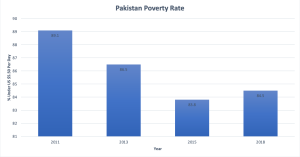144 Country Report: Data Visualization
mustafa zafar
Current issue: Poverty
Based on data from the macrotrends, in 2018, the poverty headcount ratio at $5.50 a day for Pakistan was 84.5%. This means that a large majority of the population in Pakistan was living on less than $5.50 a day at 2011 international prices. This indicates a high level of poverty in the country, which can have significant implications for the well-being and development of individuals and communities.

Poverty remains a significant issue in Pakistan, particularly in rural areas and among certain population groups such as women, children, and minorities. It is important to note that poverty is a complex issue that can be influenced by a range of factors, including economic growth, access to education and healthcare, social policies, and more. Addressing poverty in Pakistan will require a multifaceted approach that addresses these various factors and creates opportunities for people to improve their lives and well-being.

According to data from macrotrends, the poverty rate in Pakistan has been fluctuating over time but has generally shown a declining trend. The poverty rate was particularly high in 2007, at 91.4%, but decreased to 83.8% by 2015, representing a 7.6% change over time. However, the poverty rate increased to 85.5% in 2018. While there has been some improvement in recent years, poverty remains a significant challenge in Pakistan that will require sustained efforts to address.
Reference:
MacroTrends (2023). Pakistan poverty rate 1987-2023 [Data set]. https://www.macrotrends.net/countries/PAK/pakistan/poverty-rate